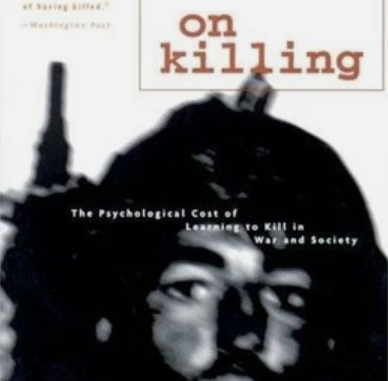
David Grossman’s book explores the psychology of the act of killing, and the military and law enforcement establishments’ attempt to understand and deal with the consequences of killing.
Grossman’s argument starts with the assertion that men have a reluctance to kill their fellow man.[1] Evidence from history demonstrate this fact. After the Battle of Gettysburg in 1863, 27,574 muskets were recovered from battlefield. It was found that 90% of these were loaded, with 12,000 of them loaded more than once. The conclusion was that men did not fire their weapon as they kept loading it.[2] During the Second World War, S.L.A Marshall estimated that around 85% of soldiers did not fire their weapon in combat.[3]
During the Vietnam War, the non-firing rate was reduced to 5% this was because the US military had used new training methods to prepare soldiers for action and had managed to overcome soldiers’ resistance to killing.[4] They were able to do this by through desensitization, conditioning and denial defence mechanisms.[5] They used Pavlovian classical conditioning and Skinnerian operant conditioning in combat training after the Second World War.[6] For instance, instead of targets on the shooting range being static concentric circles they were made to look and behave like men on the battlefield, for example, bobbing up and down and depicted carrying a firearm.[7] Men would fire their weapons as they would in combat rather than lying prone as was traditionally done on the firing range. As a consequence, the US serviceman in Vietnam was a much more lethal than his predecessor.[8] Grossman argues that this greater ability to kill was a major cause of post-traumatic stress disorder (PTSD) After the conflict, between 400k and 1.5m veterans had PTSD.[9]
The final part of his book looks at modern America and the massive rise in violence that occurred from 1957 to the mid 90s, when the book was written.[10] He argues that:
‘The three major psychological processes at work in enabling violence are classical conditioning (a la Pavlov’s dog), operant conditioning (a la B.F. Skinner’s rats) and the observation and imitation of vicarious role models in social learning’. In a kind of reverse Clockwork Orange classical conditioning process, adolescents in movie theatres…watching television at home, are seeing detailed, horrible suffering of human beings and they are learning to associate this killing and suffering with entertainment, pleasure [and]…their favourite soft drink’.[11]
He argues that violent movies desensitize the youth and provided ‘killing empowerment to an entire generation of Americans’.[12] He argues that video games trained people to react in the same way that soldiers learnt to kill on the shooting range against ‘realistic’ targets.[13]
However, this book suffers from being a combination of an analysis of why people kill or not on the battlefield to a warning about the ills affecting American society. Both topics are interesting but, in some ways, don’t work as a combination. It would have been more productive to focus on one or the other.
His argument that that violent movies and video games are desensitizing youngsters to violence probably has some merit but it is a weak argument. One reviewer pointed out that countries like Japan and South Korea have high levels of video game use and don’t have the violence that America has suffered from in the second half of the Twentieth century.[14]
Also, despite his warnings about the negative impact of video games and movies were a cause of crime, the levels of crime in the USA declined from a high in the mid-1990s.[15]
Finally, he calls for the resenitization of America but offers little in the way of practical solutions. He argues that the ‘prescription for resensitization is a complex’ and says that ‘guns, drugs, poverty, gangs, war, racism, sexism and the destruction of the nuclear family are just a few of the factors that can act to cheapen human life’.[16]
Overall, the book is, as one reviewer put it, ‘a look at an unpleasant but important subject’.[17] Grossman’s exploration of what makes people kill and how dynamics in small groups can facilitate homicide was thought provoking.[18]
[1] David Grossman, On Killing, The Psychological Cost of Learning in War and Society (New York City: Back Bay 1996), p.4.
[2] Ibid., pp.22-27.
[3] Ibid., p.3.
[4] Ibid., p.187.
[5] Ibid., p.251.
[6] Ibid., p.252.
[7] Ibid., p.253.
[8] Ibid., p.257.
[9] Ibid., p.247.
[10] Ibid., pp.299-301.
[11] Ibid., p.302.
[12] Ibid., p.309.
[13] Ibid., pp.312-316.
[14] https://berniegourley.com/2013/01/27/book-review-on-killing-by-david-grossman/ Accessed 23 August 2022.
[15] https://en.wikipedia.org/wiki/Violent_crime#United_States Accessed 23 August 2022.
[16] Ibid., pp.323-332.
[17] https://www.kirkusreviews.com/book-reviews/david-a-grossman/on-killing/. Accessed 22 August 2022.
[18] Grossman, pp.141-192.

